Greater Manchester
Explore hidden histories, historic photos, and things you never knew about Greater Manchester from the collections and archives of Historic England.
Discover your local listed buildings and places
Introducing some of Greater Manchester's most historic sites, included in the National Heritage List for England. Some of these captions have been summarised by AI. Click through for the official List entry. Skip this section and go to place by numbers
Castle Street Police Station
Bolton
Castle Street Police Station, formerly Bolton County Police Court and dating to 1876, is of special architectural and historic interest as a distinctive and well-preserved example of a...
Deep Pit railway footbridge WBS/24, including brick piers…
Hindley
A railway pedestrian overbridge of 1887, probably designed by Augustus Topp for the Lancashire and Yorkshire Railway, and made by Walker Brothers in wrought and cast iron, with...
Cavendish primary school including detached annexe and fr…
Manchester
A local authority education committee primary school begun in 1904, by Ernest Woodhouse, in Jacobean Revival style. Read the official list entry to find out more.
Charter Street Mission (formerly Charter Street Ragged Sc…
Manchester
A working girls' home, ragged school and mission hall of 1892 and 1900 by Maxwell and Tuke, comprising a three-and-four-storey trapezoidal courtyard-plan building of red brick with slate...
Former Nicholls Hospital including gymnasium, governor's …
Manchester
A bluecoat school designed 1865 to 1867 and built 1878 to 1880, by Thomas Worthington for Benjamin Nicholls, with a governor's house of approximately 1900; later a council school and a...
Manchester Oxford Road Station (including platform struct…
Manchester
Railway station building and platform structures, 1958-60, by Max Clendinning of British Railways' Midland Region with Hugh Tottenham of the Timber Development Association.
Stamford Park, Stalybridge
Stalybridge
Stamford Park, opened in 1873 by Gregory Hill, features ornamental gardens, recreational lakes, and historical elements spanning from the 19th-century development to botanical conservation...
Church of St Thomas
Leigh
A large Anglican church of 1902-10 by Richard Bassnett Preston of Preston and Vaughan, in Accrington brick with Runcorn red sandstone dressings, with later fittings designed by Sir Charles...
Queen's Park, Manchester
Manchester
Queen's Park, Manchester, designed by Joshua Major and opened in 1846, is one of the first public parks in an industrial city, featuring historical elements and engaging cultural sites.
Buile Hill Park
Salford
Buile Hill Park, a historical public park in Salford, features areas from Seedley Park, Buile Hill house, Springfield, and Hart Hill estate, with rich historical development from 1827 to...
Train shed and undercroft at Manchester Piccadilly Station
Manchester
Train shed set above a rail-served undercroft, 1866, extended 1883 with significant remodelling 1958-1966 and 1998-2002. Read the official list entry to find out more.
Peel Park
Salford
A municipal urban public park, planned in 1845 by Joshua Major and opened in 1846, altered in the C20 and refurbished in 2017.The paved terrace outside the Maxwell Building, the access road...
Ashburne Hall (Lees, Mary Worthington, Ward and Central b…
Manchester
A purpose-built women's hall of residence by Sir Percy Scott Worthington, 1910-1933, including the Alice Barlow memorial gates, 1924, and Ashburne Hall Lodge, 1926, both by Sir (John) Hubert...
Pall Mall Court, Including Raised Piazza and Podium to th…
Manchester
Commercial office building, 1966-8 by Harry Teggin of Brett, Pollen & Teggin in association with A H Brotherton and Partners, and the engineers, Cyril Blumfield and Partners.
New Century House, Including Its Attached Conference Hall…
Manchester
Office building and attached conference hall, 1959-63, by G.S. Hay, chief architect of the Co-operative Wholesale Society (CWS) with Gordon Tait of Sir John Burnet, Tait and Partners.
Co-operative Insurance Society (Cis) Building
Manchester
Office building, 1959-62, by G.S. Hay, chief architect of the Co-operative Wholesale Society (CWS) with Gordon Tait of Sir John Burnet, Tait and Partners.
Hall i' th' Wood
Bolton
Hall i' th' Wood, a small manor house now a museum, was home to Samuel Crompton during the invention of the spinning mule. Restored in 1900 by Lord Leverhulme.
Bailey Mills, New Delph
Saddleworth
Woollen textile mill. 9 bays of main spinning mill building and lower part of short NW wing, engine/boiler house, and chimney 1863.
Falinge Park
Rochdale
Falinge Park, a 20th-century public park in Rochdale, was originally a private estate designed by Thomas Mawson.
Stockport College of Further and Higher Education Annexe
Stockport
Stockport College of Further and Higher Education Annexe. Read the official list entry to find out more.
Former Premier Cafe, 3 High Street, Cheadle
Cheadle
Former café with baker's shop on the ground floor, a late-C19 building with Art Deco remodelling in the mid-1930s. Read the official list entry to find out more.
Stockport Museum in Vernon Park
Stockport
Municipal museum and art gallery, by Mills, 1860, extended 1866. Brick with stone dressings, slate roof to plain terracotta ridge. Read the official list entry to find out more.
Railway tunnel portals MVL3/41, west end of Standedge Tunnel
Saddleworth
Three railway tunnel portals at the west end of Standedge Tunnel; the centre portal built in 1845-1849 by the contractor Thomas Nicholson and engineer Alfred Stanistreet Jee for the...
Portico of Former Stalybridge Town Hall
Stalybridge
Portico arch, formerly the entrance portico to the former town hall of 1831, modified in the late 1980s. Read the official list entry to find out more.
Church of St Peter, St Peters Street, Rochdale
Rochdale
Church. 1868-1871. By James Medland and Henry Taylor. Polygonal sandstone rubble with orange brick, and blue and green slate roofs. Read the official list entry to find out more.
Ordsall Hall
Salford
Ordsall Hall, a significant early 16th-century house with 17th-century and later additions, features timber framing and historical interior elements like the 'Star chamber' with its ornate...
Chorlton Library
Manchester
Library, 1914, by Henry Price. Red brick with Portland stone dressings. Single-storey and flat-roofed. Edwardian Baroque style. Read the official list entry to find out more.
Heaton Moor Electricity Substation
Stockport
Electricity substation. c.1902 for Manchester Corporation. Red brick in English bond, with sandstone dressings, banding, entablature and parapet.
Lancashire Fusiliers Boer War Memorial
Bury
Boer War Memorial of 1905, relocated in 1920, by Sir George James Frampton, comprising a sandstone plinth with bronze inscriptions and a realistically-depicted statue of a soldier in 'review...
Farnworth Park
Farnworth
Farnworth Park, opened by William Gladstone in 1864, was designed by William Henderson and Robert Galloway on land donated by Thomas Barnes.
Philips Park
Manchester
Philips Park, designed by Joshua Major, was one of the first three public parks in Manchester, established in 1846, emphasizing public accessibility and enjoyment.
Roman Catholic Church of St Chad and attached Presbytery,…
Manchester
A Roman Catholic church with attached presbytery, now an oratory, of 1847, by Weightman and Hadfield of buff sandstone in Perpendicular Gothic style.
Wythenshawe Park
Wythenshawe
Wythenshawe Park evolved from its origins as a medieval deer park owned by the Tatton family, with notable changes in landscape and architecture over centuries.
Houldsworth Working Mens Club
Reddish
A working men's club of 1874 by A H Stott of Oldham. Read the official list entry to find out more.
Alexandra Park
Oldham
A public park laid out in the 1860s to the designs of William Henderson, and opened in 1865. Read the official list entry to find out more.
Explore more
Search for more listed placesGreater Manchester through time
This timeline shows the first period of use for buildings and places on the National Heritage List for England, just one of the details recorded for every list entry. Click around to see how Greater Manchester changes over time. Skip this section and go to aerial photos
Prehistoric Before AD 43
Prehistory covers a million years of human occupation before the Roman invasion and the introduction of writing. Primarily hunter-gatherers of several human species including Neanderthals, the peoples moved across Europe, hunting animals, exchanging ideas and developing complex culture and belief systems including burial rites and astronomical understanding, as at Stonehenge for example.
Roman AD 43 to AD 410
Britain was invaded by four legions of the Roman army in AD 43, who relatively rapidly conquered England from landing points in Kent. Parts of Wales and Scotland soon followed.
Roman culture brought urbanism, monumental buildings, wide-ranging religious beliefs, writing, and strong social hierarchy. The Roman administrative system was withdrawn in AD 410.
Early medieval AD 410 to AD 1066
This period, often associated in England with Anglo-Saxons and Vikings, saw a reduction in urban living from the Roman period and increased migration from northern Europe.
Traces of this period can be found in cemeteries, particularly in artefacts and in some of the very early churches, as this period also saw the growth of Christianity in Britain.
Medieval AD 1066 to AD 1540
This period, sometimes known as the Middle Ages, began with the Norman invasion in AD 1066. It saw a significant rise in military and defensive buildings such as castles and earthworks, as well as religious houses dominating a largely agricultural landscape.
The monarchy and Church dominated the period, which also saw the break with the Roman Catholic Church and the English reformation.
Post medieval AD 1540 to AD 1901
The Post-Medieval period brought seismic changes to life in England, with religious reformation leading to the democratization of worship and the destruction of hundreds of religious houses.
In parallel, there was a huge expansion of scientific study and enlightenment that permanently altered the nation's social structure and landscape. Industrialization and mass production lead to wider global trade, emigration, and immigration.
20th century AD 1901 to AD 2000
The 20th century saw an incredible expansion of England's transport networks, with suburban growth shadowing rapid infrastructural expansion. The establishment of state schools, hospitals, and modern technical colleges, with new architectural styles, radically changed the appearance of towns and cities.
Two catastrophic world wars and the 1918 pandemic also brought unprecedented change, altering England's built environment and social structures forever.
Prehistoric Before AD 43
Prehistory covers a million years of human occupation before the Roman invasion and the introduction of writing. Primarily hunter-gatherers of several human species including Neanderthals, the peoples moved across Europe, hunting animals, exchanging ideas and developing complex culture and belief systems including burial rites and astronomical understanding, as at Stonehenge for example.
Roman AD 43 to AD 410
Britain was invaded by four legions of the Roman army in AD 43, who relatively rapidly conquered England from landing points in Kent. Parts of Wales and Scotland soon followed.
Roman culture brought urbanism, monumental buildings, wide-ranging religious beliefs, writing, and strong social hierarchy. The Roman administrative system was withdrawn in AD 410.
Early medieval AD 410 to AD 1066
This period, often associated in England with Anglo-Saxons and Vikings, saw a reduction in urban living from the Roman period and increased migration from northern Europe.
Traces of this period can be found in cemeteries, particularly in artefacts and in some of the very early churches, as this period also saw the growth of Christianity in Britain.
Medieval AD 1066 to AD 1540
This period, sometimes known as the Middle Ages, began with the Norman invasion in AD 1066. It saw a significant rise in military and defensive buildings such as castles and earthworks, as well as religious houses dominating a largely agricultural landscape.
The monarchy and Church dominated the period, which also saw the break with the Roman Catholic Church and the English reformation.
Post medieval AD 1540 to AD 1901
The Post-Medieval period brought seismic changes to life in England, with religious reformation leading to the democratization of worship and the destruction of hundreds of religious houses.
In parallel, there was a huge expansion of scientific study and enlightenment that permanently altered the nation's social structure and landscape. Industrialization and mass production lead to wider global trade, emigration, and immigration.
20th century AD 1901 to AD 2000
The 20th century saw an incredible expansion of England's transport networks, with suburban growth shadowing rapid infrastructural expansion. The establishment of state schools, hospitals, and modern technical colleges, with new architectural styles, radically changed the appearance of towns and cities.
Two catastrophic world wars and the 1918 pandemic also brought unprecedented change, altering England's built environment and social structures forever.
Aerial photos of Greater Manchester
Aerial photography helps reveal secrets of England's changing landscapes that are impossible to see from the ground. Skip this section and go to archive images

Werneth
Hartford Cotton Mill and environs, Werneth, 1936
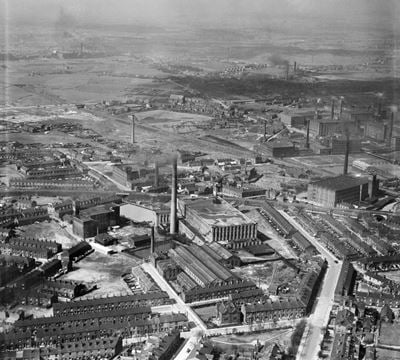
Oldham
Hartford Cotton Mill and environs, Oldham, 1947
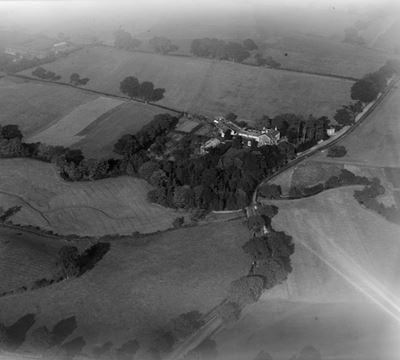
Woodford
Deanwater House, Woodford, 1927

Deanwater
Deanwater House and surrounding countryside, Deanwater, 1932
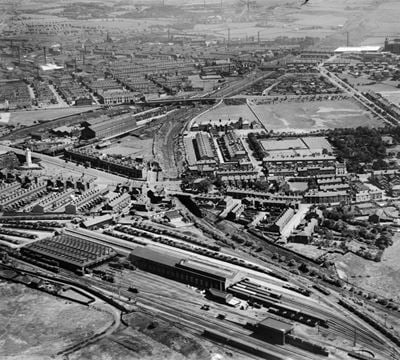
Bury
The Buckley Wells railway depot and environs, Bury, 1935

Bury
The Buckley Wells railway depot and the town, Bury, 1935

Manchester
The Royal Infirmary, Manchester, 1926
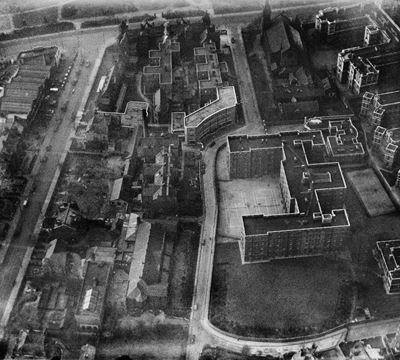
Manchester
St Mary's Hospital, Manchester, 1939
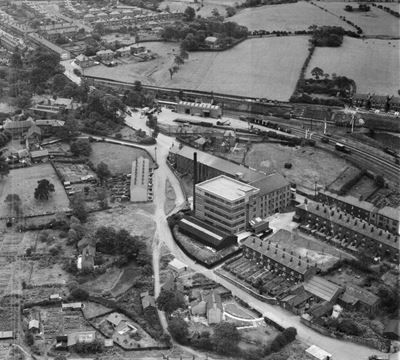
Woodley
J.G. Naylor & Co Ltd Woodley Emery Mill, Woodley, 1946
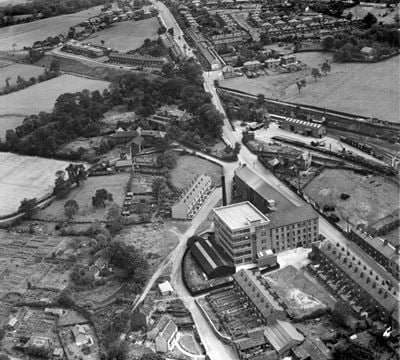
Woodley
The J C Naylor & Co Ltd Emery Mills on Hyde Road and environs, Woodley, 1946
Greater Manchester in the Historic England Archive
The Historic England Archive cares for over 15 million images, dating from the 1850s to the present day. Discover stunning images of Greater Manchester's past. Skip this section and go to stories about heritage
Charles George Harper Collection
Cheadle, Stockport
Date created: 09 Jul 1806
Watercolour painting showing the cross shaft and sundial in the churchyard of St Mary's Church
Eileen ‘Dusty’ Deste Collection
Wereneth, Oldham, Oldham
Date created: 1966 - 1974
Roundtree House tower block under construction viewed from Featherstall Road South
Eric de Mare
Manchester
Date created: 1945 - 1980
Interior view of the G Mex Centre in Manchester showing the undercroft.
John Laing Collection
Wythenshawe, Manchester
Date created: Aug 1967
A Laing worker painting on the access balcony of an eight-storey block of 'Sectra' flats in Wythenshawe
London, Midland and Scottish Railway Company
Manchester
Date created: 10 Oct 1903
A view looking north-west along a busy Piccadilly, with the statue of Arthur Wellesley, Duke of Wellington, in the foreground
Alfred Newton and Sons
Strines, Hazel Grove, Stockport
Date created: 19 May 1903
GENERAL VIEW LOOKING ACROSS STRINES AND MARPLE VALLEY FROM THE TOP OF RIDGEND STONE QUARRY
Nigel Temple Collection of Postcards of Parks and Gardens
Bramhall Park, Cheadle And Bramhall, Stockport
Date created: 1905 - 1910
GENERAL VIEW SHOWING CHILDREN FISHING FROM A RUSTIC BRIDGE
Eric de Mare
Marple, Stockport
Date created: 1945 - 1980
Copy of an aquatint showing a general perspective view of the Marple Aqueduct carrying the Peak Forest Canal, drawn in 1803, three years after it...
John Laing Collection
Wythenshawe, Manchester
Date created: Aug 1967
A view of part of an eight-storey block of 'Sectra' flats in Wythenshawe
London, Midland and Scottish Railway Company
Manchester
Date created: 10 Oct 1903
A view looking north-west along Piccadilly towards the Royal Hotel, showing the street crowded with pedestrians, trams and horse-drawn traffic
Alfred Newton and Sons
Goyt Valley, Marple, Stockport
Date created: 1903
GENERAL VIEW SHOWING MEN AT THE PLOUGH
Nigel Temple Collection of Postcards of Parks and Gardens
Edgeley, Stockport, Stockport
Date created: 1905 - 1910
GENERAL VIEW
Stories about heritage in your local area
Historic England publishes news, blogs, research, videos, and podcasts celebrating England's rich heritage. Discover the stories we have about Greater Manchester. Skip this section and go to education
Groundbreaking English Women of Science
Mentions Victoria University of Manchester Including Christie Library, Whitworth Hall
Discover the lives of women who impacted scientific discoveries in England's history, such as Marie Stopes and codebreaker Joan Clarke.
The Timeless Charm of English Market Towns and Halls
Mentions Market House, Smithfield Market Hall
Discover the history of English market towns and halls, including farmers' markets, Christmas markets, market squares and corn exchanges.
The History of Brick Building in England
Mentions Decker Mill Old Mill
Discover 7 examples of how brick building in England has changed over the centuries.
A Brief Introduction to Military Pillboxes
Mentions World War Two pillbox overlooking A62 (Huddersfield Road), Bleak Hey Nook, Standedge
Explore some of the anti-invasion defences built across England during the First and Second World Wars.
Narrative Structures: England’s Literary History in 11 Places
Mentions Chethams Hospital and Attached Wall
Discover the historic sites in England where famous writers found their inspiration.
Ghost Signs: Spooky Remains of a Hidden Past
Mentions Beehive Mill
Once you’re on the look out for ghost signs, you’ll find they are frequently hidden in plain sight.
The History of Ukrainians in England
Mentions Roman Catholic Church of St Chad and attached Presbytery, and Boundary Walls
Ukrainians have influenced several sites across England. Here is a small selection.
How Tutankhamun Influenced 20th Century Design and Architecture
Mentions Tatton Cinema
From the most expensive jewellery and furniture to public buildings, learn now Tutankhamun inspired the world of design and popular culture.
Football, Beerhouses and Books: How Victorian Mill Workers Entertained Themselves
Mentions Farnworth Park
The lives of Victorian mill workers were far from easy. So what did they do with their spare time?
11 Listed Pubs with Fascinating Histories
Mentions Old Man and Scythe Public House
Pull up a bar-stool and get familiar with some of England’s oldest pubs.
Where to Find Byzantine Architecture in England
Mentions Roman Catholic Church of St John the Baptist
Byzantium made an unexpected mark in the 19th-century as part of a mini-revival across Europe. Here’s where you can find examples in England.
Where to Find Egyptian Style Architecture in England
Mentions Tatton Cinema
‘Egyptomania’ was the height of fashion in Regency England. Here are some of the places you can see its impact.
Mentions Greater Manchester
For more videos on the restoration of Hopwood Hall, visit @HopwoodXIV. Read below for information on how to get into heritage skills!
Rescuing an Abandoned English Manor House with Hopwood DePree
For more videos on the restoration of Hopwood Hall, visit @HopwoodXIV. Read below for information on how to get into heritage skills!
Mentions Greater Manchester
Hopwood Hall is a magnificent Grade II* listed historic house in Middleton, Greater Manchester.
Restoring Hopwood Hall with Hopwood DePree
Hopwood Hall is a magnificent Grade II* listed historic house in Middleton, Greater Manchester. In 2021, Hollywood actor and author Hopwood DePree took on restoring his ancestral home along with Rochdale Council and a mighty team of local volunteers.
Mentions Greater Manchester
Textile mills once defined the North of England’s landscape. They were the world's workshop from Bolton to Blackburn, Bradford to Leeds.
Mills of the North
Textile mills once defined the North of England’s landscape. They were the world's workshop from Bolton to Blackburn, Bradford to Leeds. Sadly, the North’s historic mills are rapidly being lost.
Funding for Young People to Explore and Celebrate Their Local History
Mentions Greater Manchester
Historic England has announced new funding for 21 creative youth-led place-marking projects across England.
Heritage Place-making and Co-operative Connections in Central Rochdale
Mentions Greater Manchester
New research is supporting the Rochdale Heritage Action Zone initiative.
Historic England Supports University of Sussex Plans for Listed Library
Mentions John Rylands Library and Attached Railings, Gates and Lamp Standards`
Historic England supports plans to improve access to the University of Sussex’s Grade II* listed Library, designed by architect Sir Basil Spence.
16 Remarkable Historic Places Listed in 2023
Mentions Cavendish primary school, Deep Pit railway footbridge WBS/24,, Greater Manchester
Take a closer look at the historic gems that were examined, protected and added to the National Heritage List for England in 2023.
Pioneering Peel Park Protected and Joseph Brotherton Statue Listed
Mentions Peel Park, Statue of Joseph Brotherton, Greater Manchester
One of the first free municipal public parks in a major industrial city and a statue of Joseph Brotherton MP have been listed at Grade II by DCMS.
Historic England Calls for Action on Green Jobs Planning
Mentions Greater Manchester
Historic England has published local data on the estimated need for retrofitting skills to deliver Net Zero
Heritage at Risk in the North West Revealed
Mentions Church of the Ascension, Oldknow's limekilns, Strines Road, Greater Manchester
3 sites have been saved and 6 sites added to the Heritage at Risk Register 2023 in the North West of England.
A Preview of The Sir John Pennycuick Collection for Researchers
Mentions Greater Manchester
The Historic England Archive's Sir John Pennycuick Collection provides a photographic record of streets in early and mid-20th century England.
Bedford Shire Hall Upgraded To Grade II* Listing
Mentions Town Hall
Bedford Shire Hall, which sits within the Bedford High Street Heritage Action Zone, has been upgraded to Grade II* by the Department for Culture,...
Early Electricity Substation in Bristol is Listed
Mentions Heaton Moor Electricity Substation
An unusual example of an early municipal electricity building is listed at Grade II following Historic England's review of historic structures and...
Historic England Awards £252,000 to Repair the UK’s Oldest Surviving Railway Goods Shed
Mentions Old Warehouse to North of Former Liverpool Road Railway Station
Historic England’s grant will help to transform the building into the main entrance to the Darlington Railway Heritage Quarter.
Historic England Celebrates Ukrainian Heritage With New Listings in the North Ahead of Eurovision
Mentions Ukrainian Catholic Church of the Dormition of The Holy Mary Mother Of God, and associated boundary walls and gate piers, Ukrainian Catholic Church of SS Peter and Paul and All Saints, and associated boundary wall and gatepiers, Roman Catholic Church of St Chad and attached Presbytery, and Boundary Walls
Celebrating how the people of Ukraine have helped shape our nation over many generations.
Greater Manchester's social history through photos
Over 10,000 images from the Historic England Archive have been specially selected and re-captioned for teachers, students, and anyone who wants to learn more about their local area. Skip this section and go to grant-aided places
Wythenshawe Hall, Wythenshawe Park, Manchester, Greater Manchester
Period: Tudor (1485 - 1602)
This timber framed manor house was built in the early 16th century.
Wythenshawe Hall, Wythenshawe Park, Manchester, Greater Manchester
Tags
Worsley Old Hall, Worsley, Greater Manchester
Period: Stuart (1603 - 1713)
Worsley Old Hall is a low two storied building partly timber framed and partly of brick. It dates from the 17th century.
Worsley Old Hall, Worsley, Greater Manchester
Working Girls' Home, Manchester
Period: Victorian (1837 - 1901)
This building, established by a philanthropic society, was built in the 1890s. Part of the building was occupied by a Ragged School.
Working Girls' Home, Manchester
Woodend Mill, Manchester Road, Mossley, Greater Manchester
Period: Georgian (1714 - 1836)
This integrated cotton mill was built between c1830-40. It was built in several phases.
Woodend Mill, Manchester Road, Mossley, Greater Manchester
Withington Hospital, Nell Lane, Manchester, Greater Manchester
Period: Victorian (1837 - 1901)
This building was originally the Chorlton Union Workhouse. It was built between 1864 and 1866.
Withington Hospital, Nell Lane, Manchester, Greater Manchester
Westwood House, Raby Street, Manchester, Greater Manchester
Period: Victorian (1837 - 1901)
This building was built as a block of 6 almshouses. They have the inscription "IN MEMORIAM E.M.R. 1876".
Westwood House, Raby Street, Manchester, Greater Manchester
Tags
Wesleyan School, Wesley Street, Bury, Greater Manchester
Period: Victorian (1837 - 1901)
This Wesleyan Day and Sunday School is dated 1868. The foundation stone was laid on 16.05.1868 by James Barlow, Mayor of Bolton.
Wesleyan School, Wesley Street, Bury, Greater Manchester
Victoria Baths, Hathersage Road, Manchester, Greater Manchester
Period: Edwardian (1902 - 1913)
The Victoria Baths were designed as a prestigious baths complex by Manchester's first City Architect, Henry Price.
Victoria Baths, Hathersage Road, Manchester, Greater Manchester
Tags
Visit grant-aided places near you
These places and buildings have been helped by Historic England's financial grants. Find historic places in your neighbourhood that you never knew existed! Please note that opening times may vary. Skip this section and go to related locations
St Francis, Gorton Lane
Constructed by E. W. Pugin between 1864 and 1872 for the Order of St. Francis, St.
Victoria Baths, Hathersage Road
Victoria Baths on Hathersage Road, a Grade II* listed complex, features three entrance halls, former swimming pools, a Turkish Baths suite, exhibition...
Former Church of All Souls, Astley Street
A Grade II church*, built in Gothic Revival style and designed by Paley and Austin.
Heaton Hall, Middleton Road
An exceptional Grade I-listed 18th-century country house set within Manchester's largest public park, boasting rare decorated interiors, and designed...
Elizabeth Gaskell's House, 84 Plymouth Grove
This beautifully restored Grade II* listed home, located just one mile from Manchester city center, celebrates the life and literature of Elizabeth...
Discover more
Ready for more local heritage? Take a look at these other places nearby


